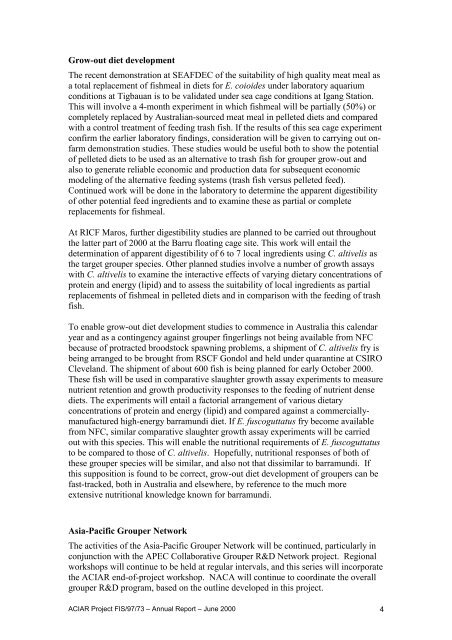ACIAR Project FIS/97/73 - Library - Network of Aquaculture Centres ...
ACIAR Project FIS/97/73 - Library - Network of Aquaculture Centres ...
ACIAR Project FIS/97/73 - Library - Network of Aquaculture Centres ...
You also want an ePaper? Increase the reach of your titles
YUMPU automatically turns print PDFs into web optimized ePapers that Google loves.
Grow-out diet developmentThe recent demonstration at SEAFDEC <strong>of</strong> the suitability <strong>of</strong> high quality meat meal asa total replacement <strong>of</strong> fishmeal in diets for E. coioides under laboratory aquariumconditions at Tigbauan is to be validated under sea cage conditions at Igang Station.This will involve a 4-month experiment in which fishmeal will be partially (50%) orcompletely replaced by Australian-sourced meat meal in pelleted diets and comparedwith a control treatment <strong>of</strong> feeding trash fish. If the results <strong>of</strong> this sea cage experimentconfirm the earlier laboratory findings, consideration will be given to carrying out onfarmdemonstration studies. These studies would be useful both to show the potential<strong>of</strong> pelleted diets to be used as an alternative to trash fish for grouper grow-out andalso to generate reliable economic and production data for subsequent economicmodeling <strong>of</strong> the alternative feeding systems (trash fish versus pelleted feed).Continued work will be done in the laboratory to determine the apparent digestibility<strong>of</strong> other potential feed ingredients and to examine these as partial or completereplacements for fishmeal.At RICF Maros, further digestibility studies are planned to be carried out throughoutthe latter part <strong>of</strong> 2000 at the Barru floating cage site. This work will entail thedetermination <strong>of</strong> apparent digestibility <strong>of</strong> 6 to 7 local ingredients using C. altivelis asthe target grouper species. Other planned studies involve a number <strong>of</strong> growth assayswith C. altivelis to examine the interactive effects <strong>of</strong> varying dietary concentrations <strong>of</strong>protein and energy (lipid) and to assess the suitability <strong>of</strong> local ingredients as partialreplacements <strong>of</strong> fishmeal in pelleted diets and in comparison with the feeding <strong>of</strong> trashfish.To enable grow-out diet development studies to commence in Australia this calendaryear and as a contingency against grouper fingerlings not being available from NFCbecause <strong>of</strong> protracted broodstock spawning problems, a shipment <strong>of</strong> C. altivelis fry isbeing arranged to be brought from RSCF Gondol and held under quarantine at CSIROCleveland. The shipment <strong>of</strong> about 600 fish is being planned for early October 2000.These fish will be used in comparative slaughter growth assay experiments to measurenutrient retention and growth productivity responses to the feeding <strong>of</strong> nutrient densediets. The experiments will entail a factorial arrangement <strong>of</strong> various dietaryconcentrations <strong>of</strong> protein and energy (lipid) and compared against a commerciallymanufacturedhigh-energy barramundi diet. If E. fuscoguttatus fry become availablefrom NFC, similar comparative slaughter growth assay experiments will be carriedout with this species. This will enable the nutritional requirements <strong>of</strong> E. fuscoguttatusto be compared to those <strong>of</strong> C. altivelis. Hopefully, nutritional responses <strong>of</strong> both <strong>of</strong>these grouper species will be similar, and also not that dissimilar to barramundi. Ifthis supposition is found to be correct, grow-out diet development <strong>of</strong> groupers can befast-tracked, both in Australia and elsewhere, by reference to the much moreextensive nutritional knowledge known for barramundi.Asia-Pacific Grouper <strong>Network</strong>The activities <strong>of</strong> the Asia-Pacific Grouper <strong>Network</strong> will be continued, particularly inconjunction with the APEC Collaborative Grouper R&D <strong>Network</strong> project. Regionalworkshops will continue to be held at regular intervals, and this series will incorporatethe <strong>ACIAR</strong> end-<strong>of</strong>-project workshop. NACA will continue to coordinate the overallgrouper R&D program, based on the outline developed in this project.<strong>ACIAR</strong> <strong>Project</strong> <strong>FIS</strong>/<strong>97</strong>/<strong>73</strong> – Annual Report – June 2000 4
















